12.09TUE
Relay Column: Dressing the Heart – Experimenting by Living Life in a Kimono (Shingo Emoto)

PROFILE

Shingo Emoto
President of Shoyosha, and teacher at coconogacco. Born in 1985 in Shimonoseki, Yamaguchi Prefecture. In 2014, he conducted research on vortex physics at the University of Tokyo Graduate School and obtained a Doctor of Science degree. In 2017, he established the private school, Shoyosha, where he continues to explore the mind, body, and life through conversations crossing the boundaries of science, philosophy, art, music, fashion, dance, and more.
Shoyosha Website
X (Formerly Twitter)
"The fashion code for the upcoming wedding seems to be 'chic'," someone told me.
I heard this rumor when I was invited to a wedding of a friend in the fashion industry. It was a casual comment someone made during a conversation with friends about what we were planning to wear to the wedding.
I knew it was meant as a joke, but for some reason it resonated with me. After all, it was a wedding where everyone from the fashion industry would be gathered. So, it was certain that people would be dressed to the nines. In essence, 'chic' was the de facto fashion code. I wondered how I, being a fashion amateur, should behave in such a circumstance. If I wore a formal suit like everyone else, I knew I would stand out and that would be the most 'uncool' thing possible.
Feeling cornered, I found myself touring a kimono shop in Asakusa the next day to get a traditional Japanese outfit for the ceremony.
Regardless of how inundated the venue might be with 'chic', I thought that by standing there in a traditional Japanese attire, I could distort the fashion code within a certain radius around me, becoming, in effect, a singularity akin to a black hole. I decided to take a gamble on such a possibility. I reminded myself that it is also a role of fashion to transform the spatiotemporal dynamics of a place, and headed to the venue, recalling Iwakura Tomomi, who traveled to the West in a full-fledged Japanese attire and top-knot at the start of the Meiji era (1868-1912).
This article is for members only.
Please register to read the rest of the article.
What you can do with a membership
- Read members-only articles
and use text-to-speech. - Unlimited article favourites
and browsing history. - Attend members-only events.
- Get the latest information
with our email newsletter.
CONCEPT VIDEO
"fashion tech news" Unveils New Logo & Concept Video
TOP ARTICLES
RELATED ARTICLES
CONCEPT VIDEO
"fashion tech news" Unveils New Logo & Concept Video
CONTACT
If you have any questions or enquiries, please enter your details in the form below.







.jpg?w=400&fm=webp)

.jpeg?w=400&fm=webp)







.png?w=400&fm=webp)

